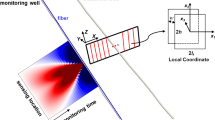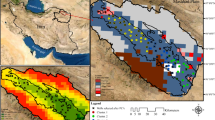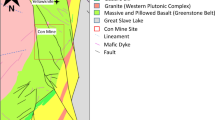Abstract
In this study, an accurate model was developed for solving problems of groundwater-pollution-source identification. In the developed model, the numerical simulations of flow and pollutant transport in groundwater were carried out using MODFLOW and MT3DMS software. The optimization processes were carried out using a differential evolution algorithm. The performance of the developed model was tested on two hypothetical aquifer models using real and noisy observation data. In the first model, the release histories of the pollution sources were determined assuming that the numbers, locations and active stress periods of the sources are known. In the second model, the release histories of the pollution sources were determined assuming that there is no information on the sources. The results obtained by the developed model were found to be better than those reported in literature.
Résumé
Dans cette étude, un modèle précis a été développé pour résoudre les problèmes d’identification de la source de pollution des eaux souterraines. Dans le modèle développé, les simulations numériques d’écoulement et de transport de polluant dans les eaux souterraines ont été réalisées en utilisant les logiciels MODFLOW et MT3DMS et les processus d’optimisation ont été conduits au moyen d’un algorithme d’évolution différentielle. La performance du modèle développé a été testée sur deux modèles d’aquifères hypothétiques en utilisant des données d’observation réelles et bruitées. Dans le premier modèle, les historiques d’émission par les sources de pollution ont été déterminés en faisant l’hypothèse selon laquelle les nombres, les localisations et les périodes d’activité des sources sont connus. Dans le second modèle, les historiques d’émission par les sources de pollution ont été déterminés en faisant l’hypothèse qu’il n’y a pas d’information sur les sources. Les résultats obtenus au moyen du modèle développé sont meilleurs que ceux rapportés dans la littérature.
Resumen
En este estudio, se desarrolló un modelo exacto para la resolución de problemas de identificación de fuentes de contaminación de agua subterránea. En el modelo desarrollado, las simulaciones numéricas de flujo y de transporte de contaminantes en el agua subterránea se llevaron a cabo usando los softwares MODFLOW y MT3DMS, y el proceso de optimización fue realizado utilizando un algoritmo diferencial de evolución. El rendimiento del modelo desarrollado se probó con dos modelos de acuíferos hipotéticos usando datos observacionales reales y ruidosos. En el primer modelo, las historias de los vertidos de las fuentes de contaminación se determinaron suponiendo conocidos los números, ubicaciones y períodos activos de las fuentes. En el segundo modelo, las historias de los vertidos de las fuentes de contaminación se determinaron suponiendo que no hay ninguna información sobre las fuentes. Se encontró que los resultados obtenidos por el modelo desarrollado eran mejores que los informados en la literatura.
摘要
在这项研究中,建立了准确模型来解决地下水污染源识别问题。在开发的模型中,采用MODFLOW和MT3DMS软件进行了地下水水流和污染物运移的数值模拟,并且采用差分进化算法进行了最优化处理。利用真实和众多的观测数据在两个假设含水层模型上对开发模型的性能进行了测试。第一个模型中,假定污染源的数量、位置和有效压力期已知,确定了污染源的释放历史。第二个模型中,假定没有污染源的任何信息,确定了污染源的释放历史。发现,所开发的模型获取的结果比文献记载的要好。
Resumo
Nesse estudo, um modelo acurado foi desenvolvido para solucionar problemas de identificação de fontes de poluição das águas subterrâneas. No modelo desenvolvido, as simulações numéricas de fluxo e transporte de poluentes foram conduzidas usando os softwares MODFLOW e MT3DMS, e o processo de otimização foi conduzido usando um algoritmo de evolução diferencial. O desempenho do modelo desenvolvido foi testado em dois modelos de aquíferos hipotéticos usando dados de observações reais e com ruído. No primeiro modelo, os históricos de liberação de fontes de poluição foram determinados assumindo que os números, locais e períodos de estresse ativo das fontes são conhecidos. No segundo modelo, os históricos de liberação de fontes de poluição foram determinados assumindo que não existe informação sobre as fontes. Os resultados obtidos pelo modelo desenvolvido foram considerados melhores do que aqueles referenciados na literatura.
Özet
Bu çalışmada, yeraltısuyu-kirlilik-kaynağı belirlenmesi ters problemlerinin çözümü için doğruluğu yüksek bir model geliştirilmiştir. Geliştirilen modelde, yeraltısuyunda akım ve kirletici taşınımı denklemlerinin sayısal simülasyonları MODFLOW ve MT3DMS yazılımları, optimizasyon işlemleri ise diferansiyel gelişim algoritması kullanılarak gerçekleştirilmiştir. Geliştirilen modelin performansı, iki adet kurgusal akifer modeli üzerinde gerçek ve hatalı gözlem verileri kullanılarak test edilmiştir. Birinci modelde, kaynakların yerleri ve sayılarının bilindiği varsayılarak kirletici kaynakların boşalım geçmişleri elde edilmiştir. İkinci modelde ise kaynaklarla ilgili herhangi bir bilgi olmadığı varsayılarak kirletici kaynakların boşalım geçmişleri belirlenmiştir. Geliştirilen modelden elde edilen sonuçların, literatürde verilen sonuçlardan daha iyi olduğu görülmüştür.




Similar content being viewed by others
References
Aral MM, Guan J (1996) Genetic algorithm in search of groundwater pollution sources. NATO ASI Ser 2(9):347–369
Aral MM, Guan J, Maslia ML (2001) Identification of contaminant source location and release history in aquifers. J Hydrol Eng 6(3):225–234
Atmadja J, Bagtzoglou AC (2001) State of the art report on mathematical methods for groundwater pollution source identification. Environ Forensic 2:205–214
Ayvaz MT (2010) A linked simulation-optimization model for solving the unknown groundwater pollution source identification problems. J Contam Hydrol 117:46–59
Bagtzoglou AC, Atmadja J (2005) Mathematical methods for hydrogeologic inversion: the case of pollution source identification. Handb Environ Chem 5(3):65–96
Bear J (1972) Dynamics of fluids in porous media. Dover, New York
Bredehoeft JD, Pinder GF (1973) Mass transport in flowing ground water. Water Resour Res 9:194–210
Butera I, Tanda MG, Zanini A (2013) Simultaneous identification of the pollutant release history and the source location in groundwater by means of a geostatistical approach. Stoch Env Res Risk A 27(5):1269–1280
Dokou Z, Pinder GF (2009) Optimal search strategy for the definition of a DNAPL source. J Hydrol 376(3–4):542–556
Dokou Z, Pinder GF (2011) Extension and field application of an integrated DNAPL source identification algorithm that utilizes stochastic modeling and a Kalman filter. J Hydrol 398(3–4):277–291
Freeze RA (1975) A stochastic-conceptual analysis of one-dimensional groundwater flow in nonuniform homogenous media. Water Resour Res 11(5):725–741
Gurarslan G (2011) Identification of groundwater contaminant source locations and release histories by using differential evolution algorithm (in Turkish). PhD Thesis, Pamukkale University, Denizli, Turkey
Gzyl G, Zanini A, Fraczek R, Kura K (2014) Contaminant source and release history identification in groundwater: a multi-step approach. J Contam Hydrol 157:59–72
Gorelick SM, Evans B, Remson I (1983) Identifying sources of groundwater pollution: an optimization approach. Water Resour Res 19(3):779–790
Jha M, Datta B (2013) Three-dimensional groundwater contamination source identification using adaptive simulated annealing. J Hydrol Eng 18:307–317
Jiang S, Zhang Y, Wang P, Zheng M (2013) An almost-parameter-free harmony search algorithm for groundwater pollution source identification. Water Sci Technol 68(11):2359–2366
Karaboga D, Okdem S (2004) A simple and global optimization algorithm for engineering problems: differential evolution algorithm. Turk J Electr Eng 12(1):53–60
Karahan H, Gurarslan G (2013) Discussion of “estimation of nonlinear Muskingum model parameter using differential evolution” by Dong-Mei Xu, Lin Qiu and Shou-Yu Chen. J Hydrol Eng 18(8):1064–1067
Mahar PS (1995) Optimal identification of groundwater pollution sources using embedding technique, PhD Thesis, IIT Kanpur, UP, India
Mahar PS, Datta B (1997) Optimal monitoring network and ground-water-pollution source identification. J Water Resour Plan Manag 123(4):199–207
Mahar PS, Datta B (2000) Identification of pollution sources in transient groundwater system. Water Resour Manag 14(6):209–227
Mahar PS, Datta B (2001) Optimal identification of groundwater pollution sources and parameter estimation. J Water Resour Plan Manag 127(1):20–29
Mahinthakumar G, Sayeed M (2005) Hybrid genetic algorithm-local search methods for solving groundwater source identification inverse problems. J Water Resour Plan Manag 131(1):45–57
McDonald MG, Harbough AW (1988) A modular three-dimensional finite difference groundwater flow model. Techniques of Water Resources Investigations, Book 6, Chapter A1, US Geological Survey, Reston, VA
Michalak AM, Kitanidis PK (2004) Estimation of historical groundwater contaminant distribution using the adjoint state method applied to geostatistical inverse modeling. Water Resour Res 40:1–14
Mirghani B, Tryby M, Ranjithan S, Zechman EM, Mahinthakumar G (2009) A parallel evolutionary strategy based simulation-optimization approach for solving groundwater source identification problems. Adv Water Resour 32(9):1373–1385
Pinder GF, Bredehoeft JD (1968) Application of the digital computer for aquifer evaluations. Water Resour Res 4(5):1069–1093
Prakash O, Datta B (2013) Sequential optimal monitoring network design and iterative spatial estimation of pollutant concentration for identification of unknown groundwater pollution source locations. Environ Moni Assess 185(7):5611–5626
Prakash O, Datta B (2014) Characterization of groundwater pollution sources with unknown release time history. J Water Resour Protect 6:337–350
Reddy MJ, Kumar DN (2007) Multi-objective differential evolution with application to reservoir system optimization. J Comput Civ Eng 21(2):136–146
Singh RM, Datta B (2006) Identification of groundwater pollution sources using GA-based linked simulation optimization model. J Hydrol Eng 11(2):101–109
Singh RM, Datta B, Jain A (2004) Identification of unknown groundwater pollution sources using artificial neural networks. J Water Resour Plan Manage 130(6):506–514
Storn R, Price K (1997) Differential evolution: a simple and efficient heuristic strategy for global optimization over continuous spaces. J Glob Optim 11:341–359
Suribabu CR (2010) Differential evolution algorithm for optimal design of water distribution networks. J Hydroinf 12(1):66–82
Vasan A, Simonovic SP (2010) Optimization of water distribution network design using differential evolution. J Water Resour Plan Manag 136(2):279–287
Wagner BJ (1992) Simultaneous parameter estimation and contaminant source characterization for coupled groundwater flow and contaminant transport modeling. J Hydrol 135:275–303
Yeh HD, Chang TH, Lin YC (2007) Groundwater contaminant source identification by a hybrid heuristic approach. Water Resour Res 43 (9), doi:10.1029/2005WR004731
Zheng C, Wang PP (1999) MT3DMS: a modular three-dimensional multispecies transport model for simulation of advection, dispersion and chemical reactions of contaminants in ground water systems—documentation and user’s guide. US Army Eng Contract Rep SERDP-99-1
Acknowledgements
This study is sponsored by Pamukkale University, Scientific Research Projects Coordination Unit (PAUBAP) with project number 2007FBE015. The authors would like to thank PAUBAP for their support.
Author information
Authors and Affiliations
Corresponding author
Additional information
Published in the theme issue “Optimization for Groundwater Characterization and Management”
Rights and permissions
About this article
Cite this article
Gurarslan, G., Karahan, H. Solving inverse problems of groundwater-pollution-source identification using a differential evolution algorithm. Hydrogeol J 23, 1109–1119 (2015). https://doi.org/10.1007/s10040-015-1256-z
Received:
Accepted:
Published:
Issue Date:
DOI: https://doi.org/10.1007/s10040-015-1256-z




